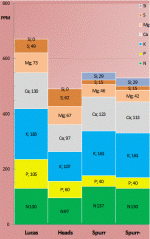taken from fatman over at rollitup:
Veg,
MAJOR ELEMENTS, Three different sets of tissue samples: The first two are Indica and the third an Indica dominant. The samples were a mix of both bract and bud leaf tissue. Total THC: 22.9, 21.8 and 20.8
Total Nitrogen (N) 4.6%...........3.25.....4.2......4.4
Total Phosphorus (P) 1.5%.......0.35....0.50....0.65
Total Potassium (k) 3.6%.........2.55....3.75....3.00
SECONDARY ELEMENTS,
Total Magnesium (Mg) 1%........0.25....0.50....0.50
Total Calcium (Ca) 4.7%..........2.45....3.45....3.10
Total Sulphur (S) 4.2%............0.25....0.25....0.45
Flower,
MAJOR ELEMENTS,
Total Nitrogen (N) 1.2%...........3.75....4.25....3.60
Total Phosphorus (P) 1.3%.......0.75....0.90....0.75
Total Potassium (k) 2.6%.........4.1.....4.5......4.3
SECONDARY ELEMENTS,
Total Magnesium (Mg) 1%........0.40....0.50....0.50
Total Calcium (Ca) 3.8%..........1.40....1.30....1.25
Total Sulphur (S) 3.2%............0.30....0.35....0.35
------------------------------------------------------
Pot Bloom
Nitrogen 267
Phosphorus 82
Potassium 291
Magnesium 93
Calcium 261
Sulfur 123
Iron 10.00
Manganese 5.00
Boron 5.00
Zinc 5.00
Copper 1.00
Molybdenum .09
not sure where he got these, just passing along if its any use to you
Veg,
MAJOR ELEMENTS, Three different sets of tissue samples: The first two are Indica and the third an Indica dominant. The samples were a mix of both bract and bud leaf tissue. Total THC: 22.9, 21.8 and 20.8
Total Nitrogen (N) 4.6%...........3.25.....4.2......4.4
Total Phosphorus (P) 1.5%.......0.35....0.50....0.65
Total Potassium (k) 3.6%.........2.55....3.75....3.00
SECONDARY ELEMENTS,
Total Magnesium (Mg) 1%........0.25....0.50....0.50
Total Calcium (Ca) 4.7%..........2.45....3.45....3.10
Total Sulphur (S) 4.2%............0.25....0.25....0.45
Flower,
MAJOR ELEMENTS,
Total Nitrogen (N) 1.2%...........3.75....4.25....3.60
Total Phosphorus (P) 1.3%.......0.75....0.90....0.75
Total Potassium (k) 2.6%.........4.1.....4.5......4.3
SECONDARY ELEMENTS,
Total Magnesium (Mg) 1%........0.40....0.50....0.50
Total Calcium (Ca) 3.8%..........1.40....1.30....1.25
Total Sulphur (S) 3.2%............0.30....0.35....0.35
------------------------------------------------------
Pot Bloom
Nitrogen 267
Phosphorus 82
Potassium 291
Magnesium 93
Calcium 261
Sulfur 123
Iron 10.00
Manganese 5.00
Boron 5.00
Zinc 5.00
Copper 1.00
Molybdenum .09
not sure where he got these, just passing along if its any use to you





